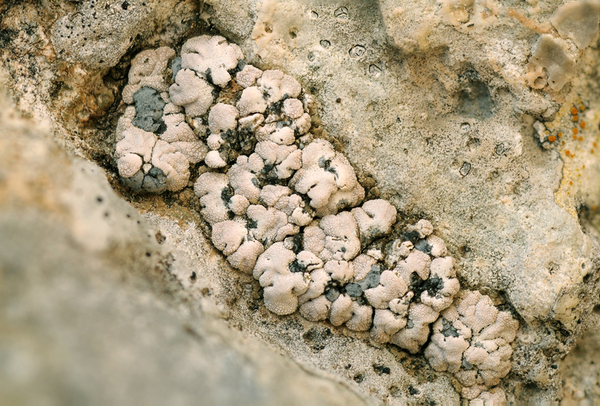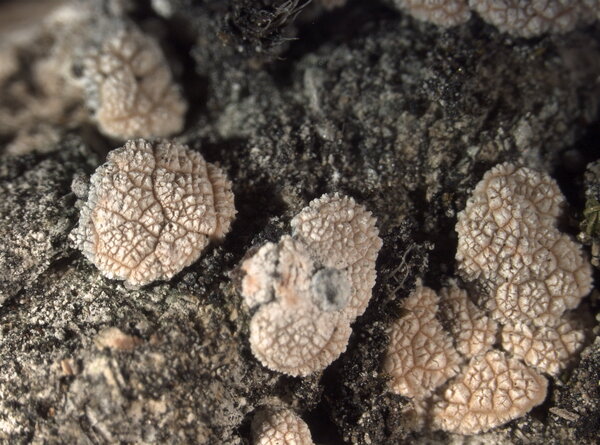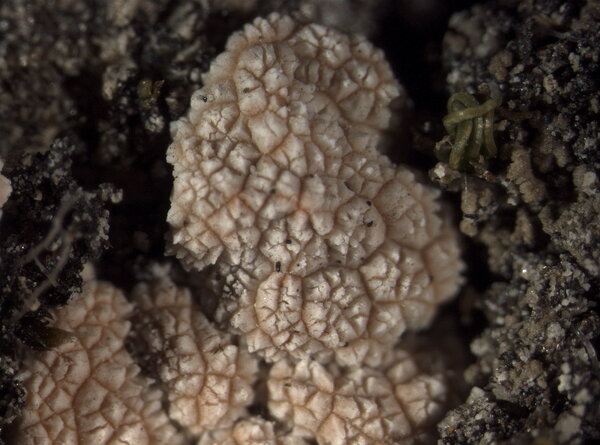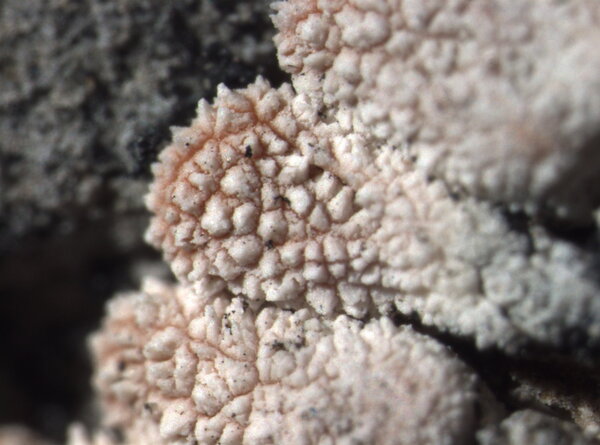Thalloidima toninianum (A. Massal.) A. Massal.
Mem. Lichenogr.: 122, 1853.. Basionym: Thalloidima mammillare var. toniniana A. Massal. - Ric. Auton. Lich. Crost.: 97, 1852.
Synonyms: Biatorina toniniana (A. Massal.) Jatta; Lecidea caesiocandida Nyl.; Thalloidima caesiocandidum (Nyl.) Arnold; Toninia caesiocandida (Nyl.) Th. Fr.; Toninia toniniana (A. Massal.) Zahlbr.
Distribution: N - VG, Frl, Ven (Lazzarin 2000b), TAA (Nascimbene & al. 2022), Lomb (Ravera & al. 2022), Piem (TSB 34194), VA (Piervittori & Isocrono 1999). C - Tosc, Marc (TSB 31366).
Description: Thallus squamulose, forming regular to irregular rosettes, the squamules closely adpressed, contiguous, up to 3 mm wide, flat to moderately convex, pale pink under a thick, white, granular pruina, with regular fissures in the cortex; lower side pale brown to brown-black. Upper cortex 60-140 µm thick, including an up to 80 µm thick epinecral layer densely incrusted by crystals of calcium oxalates; medulla white, lacking crystals; lower cortex thinner than the upper one, lacking crystals, often dark-coloured. Apothecia frequent, lecideine, to 1 mm across, black but usually pruinose, persistently marginate. Proper exciple brownish black in outer rim, paler brown in inner part, K-, N+ faintly violet; epithecium olivaceous brown to green, K-, N+ violet, with crystals; hymenium colourless, 60-70 µm high; paraphyses not conglutinated, simple or sparingly branched and anastomosing in upper part, thin-walled, the apical cell distinctly swollen, with a gelatinous pigment cap; hypothecium brown. Asci 8-spored, clavate, surrounded by a gelatinous I+ blue coat, with a well-developed I+ blue tholus, a I+ darker blue tube and a well-developed ocular chamber, Bacidia-type. Ascospores (0-)1-septate, hyaline, ellipsoid to shortly bacilliform, 9.5-17(-20) x 3.5-5 µm. Photobiont chlorococcoid. Spot tests: thallus K-, C-, KC-, P-, UV-. Chemistry: thallus without lichen substances.Note: a mainly Mediterranean to submediterranean species found on steeply inclined to slightly rain-sheltered seepage tracks of calcareous rocks, always in association with cyanobacterial colonies.
Growth form: Squamulose
Substrata: rocks
Photobiont: green algae other than Trentepohlia
Reproductive strategy: mainly sexual
On otherwise dry surfaces with short periods of water seepage after rain
Commonnes-rarity: (info)
Alpine belt: absent
Subalpine belt: extremely rare
Oromediterranean belt: absent
Montane belt: very rare
Submediterranean belt: very rare
Padanian area: absent
Humid submediterranean belt: very rare
Humid mediterranean belt: absent
Dry mediterranean belt: absent
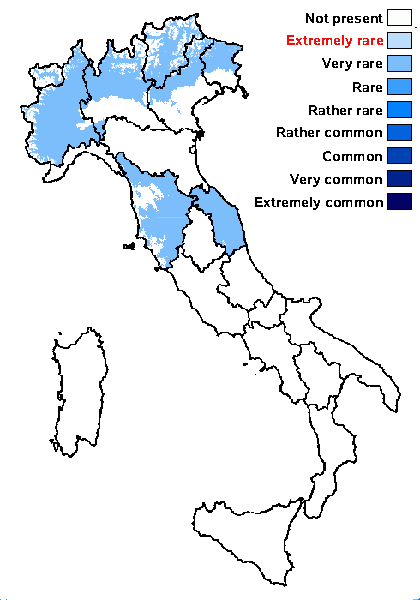
Predictive model
Herbarium samples
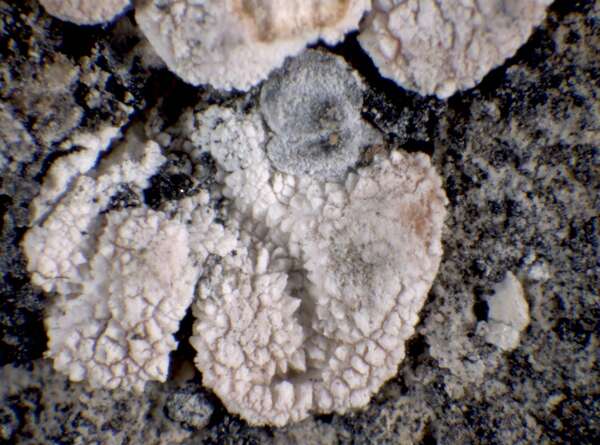

P.L. Nimis; Owner: Department of Life Sciences, University of Trieste
Herbarium: TSB (2298)
2001/12/01
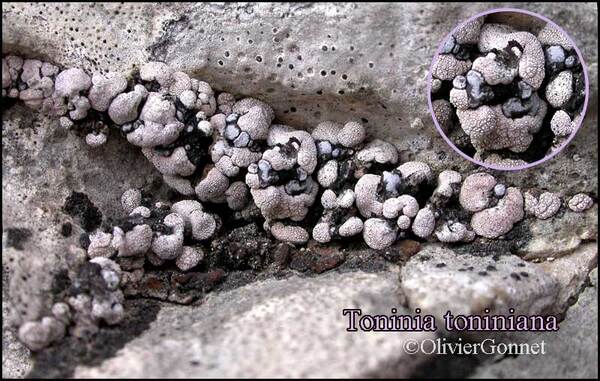
Courtesy Danièle et Olivier Gonnet - Source: https://www.afl-lichenologie.fr/Photos_AFL/Photos_AFL_T/Textes_T2/Thalloidima_toninianum.htm
France, sur roche fissurée - session AFL 2005 - Lozère

Courtesy Danièle et Olivier Gonnet - Source: https://www.afl-lichenologie.fr/Photos_AFL/Photos_AFL_T/Textes_T2/Thalloidima_toninianum.htm
France, sur roche fissurée - session AFL 2005 - Lozère
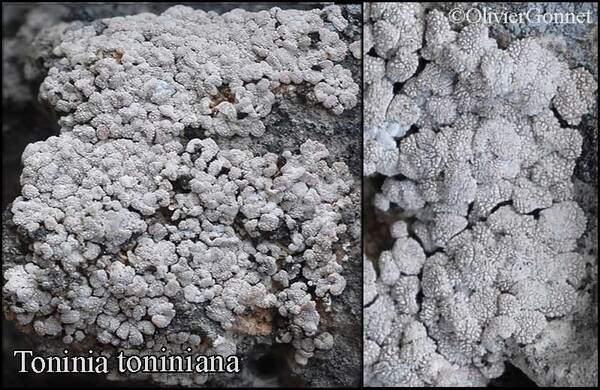
Courtesy Danièle et Olivier Gonnet - Source: https://www.afl-lichenologie.fr/Photos_AFL/Photos_AFL_T/Textes_T2/Thalloidima_toninianum.htm
France, sur roche fissurée - session AFL 2005 - Lozère
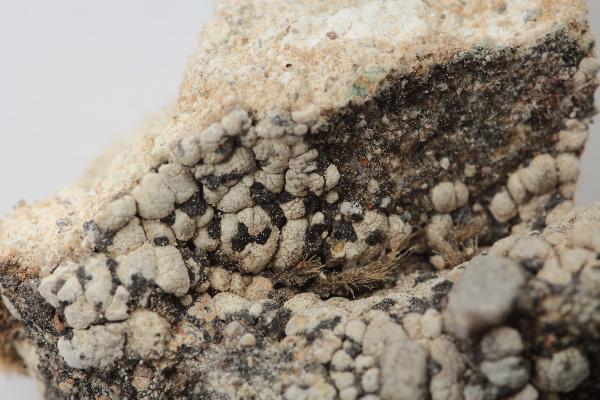
Collezione lichenologica Abramo Massalongo del Museo di Storia Naturale G. Ligabue di Venezia - Autori: Seggi, Linda; Trabucco, Raffaella Proprietà: Fondazione Musei Civici di Venezia - CC BY-NC
Italy, Veneto, in op. Avesa Tonini rarissima
as Thalloidima mammillare
Growth form: Squamulose
Substrata: rocks
Photobiont: green algae other than Trentepohlia
Reproductive strategy: mainly sexual
On otherwise dry surfaces with short periods of water seepage after rain
Commonnes-rarity: (info)
Alpine belt: absent
Subalpine belt: extremely rare
Oromediterranean belt: absent
Montane belt: very rare
Submediterranean belt: very rare
Padanian area: absent
Humid submediterranean belt: very rare
Humid mediterranean belt: absent
Dry mediterranean belt: absent

Predictive model
| Herbarium samples |


P.L. Nimis; Owner: Department of Life Sciences, University of Trieste
Herbarium: TSB (2298)
2001/12/01

Courtesy Danièle et Olivier Gonnet - Source: https://www.afl-lichenologie.fr/Photos_AFL/Photos_AFL_T/Textes_T2/Thalloidima_toninianum.htm
France, sur roche fissurée - session AFL 2005 - Lozère

Courtesy Danièle et Olivier Gonnet - Source: https://www.afl-lichenologie.fr/Photos_AFL/Photos_AFL_T/Textes_T2/Thalloidima_toninianum.htm
France, sur roche fissurée - session AFL 2005 - Lozère

Courtesy Danièle et Olivier Gonnet - Source: https://www.afl-lichenologie.fr/Photos_AFL/Photos_AFL_T/Textes_T2/Thalloidima_toninianum.htm
France, sur roche fissurée - session AFL 2005 - Lozère

 DOLICHENS
DOLICHENS
